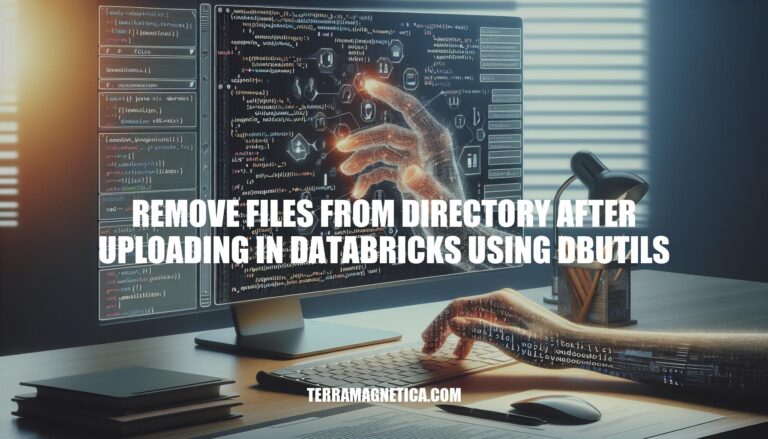


In Databricks, after uploading files to a directory, it’s often necessary to remove them to maintain a clean and organized workspace. This can be efficiently done using the dbutils.fs.rm command. This process is crucial in data management as it helps in freeing up storage space, ensuring data security, and maintaining an organized file system, which is essential for efficient data processing and analysis.
Databricks Utilities (dbutils) provide a set of tools to help you manage your Databricks environment. Specifically, the file system utilities (dbutils.fs) are designed to work with the Databricks File System (DBFS) and other file systems.
dbutils.fs.ls(path) to list files and directories at a given path.dbutils.fs.mkdirs(path) to create a directory at the specified path.dbutils.fs.rm(path, recurse=True) to remove files or directories. The recurse parameter allows for recursive deletion.dbutils.fs.mv(source_path, destination_path) to move or rename files and directories.dbutils.fs.cp(source_path, destination_path, recurse=True) to copy files or directories. The recurse parameter allows for recursive copying.These utilities make it easy to manage files and directories within Databricks, streamlining workflows and enhancing productivity.
Here are the common methods and tools for uploading files to a directory in Databricks:
Databricks UI:
Databricks CLI:
databricks fs cp /path/to/local/file dbfs:/path/to/destination
```[^2^][2].
Databricks REST API:
Databricks File System Utilities:
%fs or dbutils.fs commands within a notebook to interact with files:dbutils.fs.cp("file:/local/path", "dbfs:/path/to/destination")
```[^2^][2].
These methods allow you to upload and manage files efficiently in Databricks.
Here are the steps to remove files from a directory in Databricks using dbutils:
List Files in the Directory:
files = dbutils.fs.ls("dbfs:/path/to/directory")
Remove Each File:
for file in files:
dbutils.fs.rm(file.path)
Remove Directory Recursively (if you want to delete the entire directory):
dbutils.fs.rm("dbfs:/path/to/directory", recurse=True)
Assume you have uploaded files to dbfs:/FileStore/mydata/ and want to delete them:
List Files:
files = dbutils.fs.ls("dbfs:/FileStore/mydata/")
Remove Files:
for file in files:
dbutils.fs.rm(file.path)
Remove Directory Recursively:
dbutils.fs.rm("dbfs:/FileStore/mydata/", recurse=True)
These commands will help you manage and clean up your directories in Databricks efficiently.
Here are some best practices for removing files from a directory after uploading in Databricks using dbutils:
Use Recursive Deletion:
recurse=True parameter.dbutils.fs.rm("dbfs:/path/to/directory", recurse=True)
Check for File Existence:
if dbutils.fs.ls("dbfs:/path/to/directory"):
dbutils.fs.rm("dbfs:/path/to/directory", recurse=True)
Parallel Deletion:
from concurrent.futures import ThreadPoolExecutor
def delete_file(path):
dbutils.fs.rm(path, recurse=True)
paths = [file.path for file in dbutils.fs.ls("dbfs:/path/to/directory")]
with ThreadPoolExecutor() as executor:
executor.map(delete_file, paths)
Error Handling:
try:
dbutils.fs.rm("dbfs:/path/to/directory", recurse=True)
except Exception as e:
print(f"Error deleting files: {e}")
Logging:
import logging
logging.basicConfig(level=logging.INFO)
logger = logging.getLogger(__name__)
def delete_and_log(path):
try:
dbutils.fs.rm(path, recurse=True)
logger.info(f"Deleted: {path}")
except Exception as e:
logger.error(f"Error deleting {path}: {e}")
paths = [file.path for file in dbutils.fs.ls("dbfs:/path/to/directory")]
for path in paths:
delete_and_log(path)
These practices ensure efficient and error-free file management in Databricks.
Use dbutils.fs.rm() with the recurse=True parameter to delete all files and subdirectories within the specified path.
Before attempting deletion, check if the file or directory exists using dbutils.fs.ls().
For large directories, consider parallelizing the deletion process using concurrent.futures.
Implement error handling to manage any issues that arise during deletion, and maintain logs of deleted files for auditing and troubleshooting purposes.
These practices ensure efficient and error-free file management in Databricks.